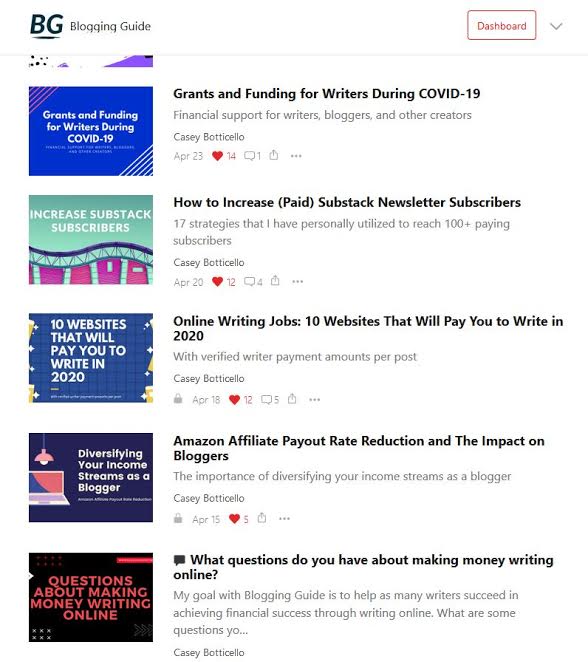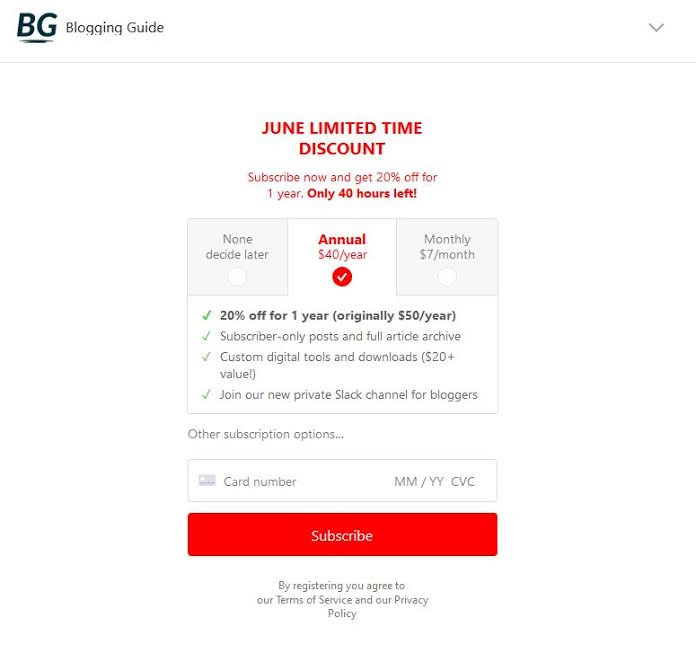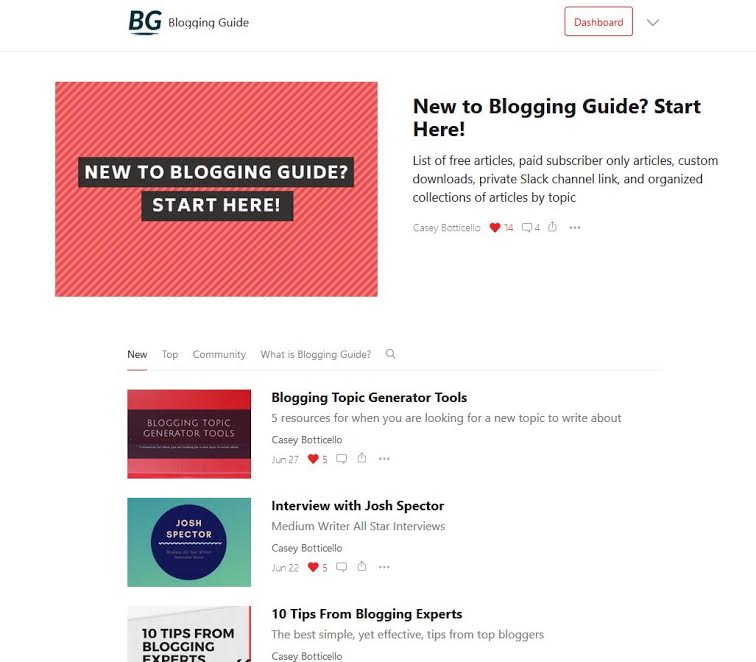Growing a Subscription Newsletter by Teaching Others to Do the Same
Hello! What's your background, and what are you working on?
My name is Casey Botticello, and I'm an entrepreneur, digital marketing consultant, and private equity investor. I'm a partner at Black Edge Consulting, a strategic communications firm, specializing in online reputation management, digital marketing, and crisis management. I'm also the founder and former president of the Cryptocurrency Alliance, an independent expenditure-only committee (Super PAC) dedicated to cryptocurrency advocacy. I previously worked at a tech startup, a lobbying firm, and in real estate development. I'm a graduate of The University of Pennsylvania.
Recently, I have been focused on building a Substack newsletter and online community called Blogging Guide.
Blogging Guide is a premium Substack publication which helps writers navigate the digital publishing landscape and shows them how to monetize their content. Blogging Guide was awarded the Substack Independent Writer Grant for 2020. Blogging Guide has over 150 paying subscribers, and roughly $500 MRR.
What motivated you to get started with Blogging Guide?
I've always been fascinated by the digital publishing world. I'm both a blogger and an avid observer of any new and emerging platforms developed to help creators.
One of the toughest things about becoming a blogger is trying to navigate through the sea of vague and dated articles and guides. I was writing on Medium about a variety of topics, but I was also curious about how platforms like Medium actually worked, how product managers made decisions, and how writers selected which platform they would trust to host their content.
After writing a number of articles deconstructing every minute detail of writing on Medium, through my publication Medium Blogging Guide, I knew there was further demand for this type of practical and useful content.
I decided to focus on the larger digital publishing industry (as opposed to just one platform like Medium), and I later created the Blogging Guide newsletter.
While I knew I had created a lot of valuable content specific to Medium, I was initially worried that my writing may only be financially successful under Medium's partner program. However, I admired the business model Substack was just beginning to promote, and decided to launch Blogging Guide on Substack, as a newsletter/blog hybrid with an associated online community for writers.
What went into building the initial product?
When I first had the idea for Blogging Guide, I was writing part time on Medium and focused on my consulting business for the majority of my income. However, I was excited at the potential to combine two of my passions: writing and creating a new business.
While I originally thought I could repurpose a lot of the content from Medium to Substack, I quickly realized that if I was going to do a premium newsletter, the content would all need to be 100% original. This meant I'd need to produce a lot of new content.
So I started drafting potential posts in my spare time while I tried to figure out at least a vague content calendar and editorial direction for the newsletter.
I surveyed some of my Medium readers and members of a few of the related writing Facebook groups I ran, and received a lot of positive feedback. I think the next steps are best explained in a timeline.
An Abbreviated Timeline of Events:
- January 1, 2020 I decided that there was enough interest to proceed with Blogging Guide based on reader feedback.
- January 24, 2020 I launched Blogging Guide on Substack. I did not initially monetize the newsletter.
- February 3, 2020 I enabled paid subscriptions for my Blogging Guide. I initially planned to keep the newsletter 100% free for a longer period of time, but I was pleasantly surprised with the traffic my newsletter initially received.
- February 7, 2020 I received my first paid subscriber! I was stunned to receive the email notification. I had only written one paid-subscriber-only post a few days earlier, and figured it would require AT LEAST a month of publishing/large enough back catalogue to get a reader to even consider subscribing. I was so surprised at how quick someone had subscribed, that I actually emailed the first subscriber to make sure they understood what they were subscribing to! Haha. This "Zero to One" moment (there were no other newsletters on Substack charging readers for access to content about what was essentially a rival platform) was a real game changer. The concept worked, someone found value in my writing, and I could charge for content that was higher quality and more in depth, that would be restricted to those who cared about digital publishing platforms as much as I did.
- April 20, 2020 Blogging Guide reached 100 paid subscribers. This was an amazing moment! And I still can't believe how fast I reached it! I consider this the major milestone which validates the concept of my newsletter. In the context of the "1000 True Fan Theory" which this whole experiment was based off of, I am now 10% of the way to reaching a sustainable passion economy based business.
What's your tech stack?
In terms of the products I used for Blogging Guide, the set up was actually quite simple.
- Substack: Functioned as my blog, email marketing system, and CRM tool
- Slack: To create an additional space for paying subscribers
- Gumroad: To distribute free digital downloads automatically to members when they subscribed
- Stripe: Was my payment processor (typical of Substack newsletters)
Because all of these are free products (or at least offer key features for free), Blogging Guide didn't actually require almost any initial funding. As is the case with most of my digital entrepreneurial ventures, it required me investing my time. While I value my time highly, this is advantageous because there was almost no overhead, limited financial risk, the newsletter model is perfectly scalable, and I didn't need anyone else to run Blogging Guide.
How have you attracted users and grown Blogging Guide?
I monetized an audience I had already spent more than a year building. Blogging Guide was the natural next step for me. I'm fortunate to have engaged with and helped many bloggers in the months and years leading up to this, effectively building my own audience.
I won a writing grant from Substack which helped boost my visibility and gave my newsletter some additional credibility.
I actively promote Blogging Guide across many of my social media platforms. This could consist of reposting key lead-generating articles or simply including my newsletter URL in various profile bios.
I've continued to manage online communities of related users (mainly my Medium Writing Facebook group). These are some of my biggest supporters and the people I have interacted personally with the most.
I've written some related guest posts to help expand my audience, been a guest on a few
podcasts, and was featured on a YouTuber's channel, with over 1.5 million followers as a Subject Matter Expert on blogging.
For tips on growing your Substack newsletter and converting free sign ups to paid subscribers, I'll recommend this article I wrote which covers this topic in great detail.
For those who are on the fence about creating a subscription newsletter (on any platform), my general advice is to give it a shot if you have a decent following (on any platform or online forum) or you are really passionate about a niche topic.
Subscription newsletters have technically existed for a long time, but there's never been an easier time to create one without any tech savvy. Not to mention that the process of using a platform like Substack is infinitely easier than having separate sites/platforms (such as your own website, hosting, third party payment processor correctly integrated into your site, using Mailchimp or some other costly email marketing system, etc).
Subscription newsletters are not only a great way to earn some extra money, but the flexibility and scalability of digital publishing allow for a single content creator to effectively leverage their limited time. Subscription newsletters also act as a portfolio of work, and can be used to help promote your related products, companies, or even articles on other sites.
What's your business model, and how have you grown your revenue?
My business model is fairly simple. Subscribers pay for either monthly or annual access to my premium newsletter, online community (Slack), for my free digital products, and discounts on another related newsletter that I run, Canva Design. I indirectly make money through any new consulting clients that are a result of my newsletter.
I received a lot of positive comments and feedback during initial 100% free sign up period. When I did decide to monetize my newsletter, I set the price as low as Substack would let me ($5 per month or $30 per year). On top of that, I offered a 50% discount to initial subscribers (so it actually cost $2.50 per month or $15 per year).
Even though this is a very low price point, I was worried few people would subscribe, if any, given that most writers already balk at paying $5 per month or $50 per year for reading articles on Medium. I thought that I would test out this low price point for three months or so, and see if I could even get a single subscriber.
Much to my surprise, four days after I enabled monetization on my newsletter, I had my first paying subscriber!
Today I'm generating approximately $500 in MRR. Most of my subscribers have annual subscriptions, and since I have been operating for less than a year, I am not sure what the annual subscriber churn rate will look like (there has been very low churn among the few monthly subscribers).
What are your goals for the future?
Very long-term, I am hoping to eventually reach 1,000 full-price subscribers. This is roughly the point where I could do less consulting work and focus more on my newsletter (as well as other entrepreneurial ventures).
I think I could achieve this goal by simply continuing what I am doing now, writing the newsletter with modest promotion, but it would take longer than I would like. So I anticipate I will experiment more with paid advertisements, sponsorships, and collaborating with other writers, to help accelerate my growth.
The main barrier is that I need to expand my audience far beyond the original core "Medium blogger" audience. Much of my expertise is Medium-specific, and while I study all the major digital publishing platforms (and have lots of broader blogging insights), I don't have quite the name recognition or established audience on some of the other platforms.
Have you found anything particularly helpful or advantageous?
I've found the following platforms and products very helpful in creating Blogging Guide:
- Substack: Underlying subscription newsletter architecture
- Medium: Amazing audience reach and SEO
- Gumroad: Facilitating digital downloads of my products
- Slack: Communication
- Notion: Content calendars, workflows, and general organization
- Indiehackers: Support and inspiration as entrepreneur
- Canva: Creating images for posts
I think that my determination and laser focus has also been a major asset in creating Blogging Guide. A subscription newsletter is a long-term business venture and needs to be treated as such. I was prepared for subscriber growth to be much slower than it has actually turned out to be.
It probably also helped that I have developed a number of streams of passive
income over the past decade which have given me the financial flexibility to even explore this idea.
There is also probably some amount of success attributable to random timing. For example, I launched this business during the beginning of a global pandemic. Many traditional businesses were destroyed by this, while the online publishing industry (for indie writers, not traditional media) has actually flourished in many ways.
What's your advice for indie hackers who are just starting out?
Don't be deterred by a lack of tech skills. Anyone can become a successful entrepreneur with the suite of no-code tools and user-friendly software that is now available.
Perfection truly is the enemy of success. This is something I still grapple with personally, but I think people tend to overlook this advice.
There are really only two ways to make money directly through writing: having content that's useful or entertaining. Don't fall into the trap of writing for yourself if you are primarily concerned with making money.
Explore every free tool you can get your hands on! Almost all the tools I utilized to create Blogging Guide (and many other profitable businesses) were 100% free. You don't need to spend a fortune on enterprise solutions or software intended for larger users. Many of the amazing free tools that I discovered actually inspired what I ultimately created.
I'm not a proponent of "Hustle Culture" at the expense of your health. Conversely, being an entrepreneur requires enormous amount of time, and it's rarely conducive to a healthy work life balance. Which is why passion for your projects is so critical. Be prepared to work hard. Regardless of whether you're successful or not, you will almost certainly invest a massive amount of time just exploring and developing a new product or service.
Don't get caught up trading time for money performing a task similar to your entrepreneurial venture. For example, if you are a writer looking to create a newsletter or some sort of community, you'll get a lot of offers to perform freelance work as you get closer and closer to success. Not only will the number of clients increase as your standing in your niche community rises, but the rate that clients will pay you will increase. A lot of people "sell out" at this point, take the higher wage, and abandon their passion project. I've seen this happen many times. If you make it that far, don't settle for a higher paying version of freelance work.
Where can we go to learn more?
- You can check out my Substack newsletter referenced in this article, by visiting Blogging Guide. I also have a related Substack newsletter called
Canva Design, which sends out custom Canva templates which can be edited using Canva's free software. Additionally I have a free newsletter on Substack, called Personal Finance that I write with my buddy Chris. - If you want to reach out to me you can do so through my personal
website, or message me on Twitter or LinkedIn. - To read some of my writing, you can view my Medium profile and read some of my most popular articles.
Thanks for taking the time to read this! Let me know if you have any questions in the comments below.
I'm also always open to collaborating with fellow entrepreneurs on new projects, so feel free to send me an email: [email protected].




Very interesting @Casey_Botticello, thanks.
Can you elaborate on how you use Gumroad for free download? I'm not much familiar with the platform and thought it supported only paid digital products.
What you said about exploring tools highly resonates with me. Being a geek I love exploring new tools as a source of project ideas.
Never mind, you explained how you use Gumroad to deliver free downloads in strategy 1 of your guide to increasing paid subscribers. It's brilliant.
Thanks @PaoloAmoroso! I plan to do a more detailed write up on Gumroad soon and I'll be sure to share it with you! There are many ways to use it to distribute digital products!
That will be useful, thanks.
What a great content! Your "Escaping the 9-5" is just brilliant!!
Is because of content like this and people like you that make me love IndieHackers.
Thanks for featuring my interview! I'm an avid reader of Indie Hackers, so seeing it appear in my inbox was pretty cool!
As a follow up to some of the content in this interview, I have since launched a new website, which aggregates many of the resources I've created. The website is BloggingGuide.org.
Also, as a way of saying thanks to the Indie Hackers community, I'm offering a 25% discount to my newsletter (and associated content of ~$250 value) exclusively to Indie Hackers users. Make sure you click here to get the discount.
Thanks!
I started following you the past couple of weeks and I'm really enjoying your content. Great work Casey and I can't wait to see what you do in the future. 😊
Thanks so much Michael!